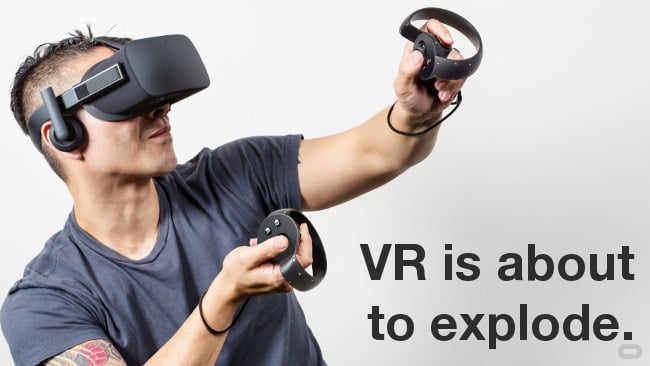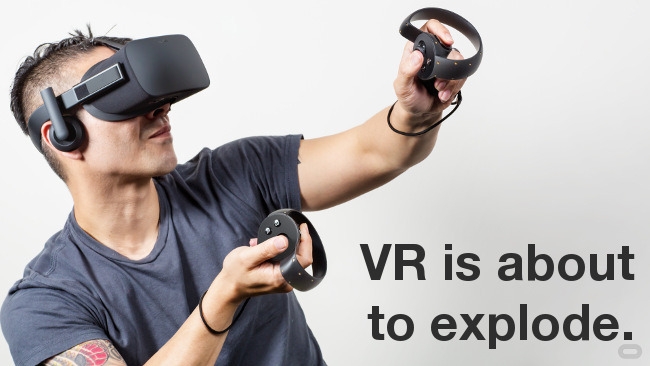
 Oculus Rift: Consumer Version
Oculus Rift: Consumer Version
Virtual and augmented reality have been on the periphery of the consumer technology landscape for some time now. But that may be about to change, as recent activity suggests we're in the early days of a boom period.
If you've been closely following developments in the burgeoning virtual reality (VR) and augmented reality (AR) industries, then you may have come to the same conclusion as many industry analysts: we're at the beginning of a tremendous growth period for technologies that have the potential to impact our lives in profound ways.
Of course, there are the naysayers that cite a plethora of reasons why VR/AR, at least in this infant stage, won't be as popular as manufacturers and content creators hope they will be. Pundits refer to the need for higher pixel density displays (for VR), that the tech could negatively impact users' health, that VR/AR are simply novelties, like stereoscopic 3D, which will similarly fail to achieve widespread consumer adoption.
While the above objections seem valid (and, to a certain extent, they are), it's impossible to ignore the incredible activity in the VR/AR field over the past couple of years. If early VR/AR is a 'bad bet', it's at least a wager that's shared by the biggest names in consumer tech and Hollywood content creation.
Follow the money
According to VR firm Virt, total investor funding for VR/AR was near $3B - a figure that doesn't include internal investment from the likes of Google, Samsung, Microsoft, HTC and Sony. Of that $3B, over 95% was earmarked for hardware development, which makes sense. Manufacturers are hard at work designing not just products, but technological platforms for future content. Much of the content produced right now exists mainly to showcase products at specific stages of development - in other words, like many of the products, the content is not quite consumer-ready...yet. However, the sheer amount of development dollars being poured into to VR/AR represents an increasingly high stakes proposition for companies that wish to stake a claim to the VR/AR mantle.
Industry projections
Over the next few years, winners and loser will undoubtedly emerge, as it's highly unlikely that all of these companies (and those waiting in the wings) will be successful in the virtual reality and augmented reality market. The VR/AR industry itself, however, is being pegged by analysts as a dynamic growth arena.
Last year, digital consulting firm KZero Worldwide predicted the virtual reality tech market to reach $5B in 2018; more recent projections assume 25 million users by 2018, accounting for a $10B market. In May, leading investment firm Piper Jaffray declared virtual reality "the next mega tech theme" and predicts the virtual reality market to reach $60B in ten years. Some recent conservative estimates, which claim that VR will be niche products for 5-7 years, still forecast a $60B industry by 2025. When business investing site Digi-Capital grouped VR and AR together for analysis, the projections jumped to $150B by 2020.
Projections such as these should be taken with some skepticism, but enough of these educated guesses, when taken together, present a range of possible outcomes. The big takeaway here is that even the most conservative estimates assume enough consumer adoption that the industry won't collapse in the starting gates; in fact, most analysts aren't debating whether VR/AR will hit big, but 'when'.
Consumer VR rush
Consumer virtual reality tech is finally going mainstream, with multiple products set to debut later this year through the first half of 2016 from premier manufacturers:
- Leading video game publisher Valve and mobile device maker HTC will introduce its headset Q4 2015.
- Sony's virtual reality headset accessory for the Playstation 4, Morpheus, will go on sale in the first half of 2016.
- Facebook's Oculus Rift consumer headset will ship in Q1 2016.
In addition, Samsung is now shipping the second version of its Gear VR headset, which uses high-end Samsung phones as the screen/sensing device, as well as scores of similar products coming out of China that are adaptable for use with most smartphones.
Current developments in AR, which (as you probably know) differs from virtual reality by blending digital visuals into your normal field of view, are being furthered by two major players:
- Microsoft, which will release the Hololens near the Windows 10 launch later this summer.
- Magic Leap, which received $500M in funding from Google for its competing augmented reality device (unlikely to be released until late 2016).
There's so much money and work-hours involved with developing these products that it would be extremely difficult to keep a competing VR/AR project completely under wraps. More than likely, if a VR/AR hardware product or company is going to bring a significant product to market in the next year-or-so, it will be one of the devices listed above.
Content Call
Of course, there is always the off-chance that an outlier, a startup or an established company in a related field, will develop a virtual or augmented reality hardware product that will disrupt the burgeoning market, as presently over 200 companies are hiring workers in the field. Yet, many of these new hires will be on the content side, as there will undoubtedly be a need for specialized content that leverages the technological advantages of VR/AR over that of more traditional media.
Hollywood studios and insiders have taken notice. Mandalay Entertainment CEO Peter Guber has reportedly invested "millions" in NextVR, a startup developing an end-to-end virtual reality production and exhibition process for live entertainment. Well-funded startup Jaunt VR is developing a cinematic toolset for virtual reality cinema production, which should spur more production. Another startup, VRFilms, is comprised of a collection of artists and engineers from Pixar, Industrial Light & Magic, Disney and Electronic Arts, and specializes in next-gen virtual reality production. Universal, ABC, Discovery Communications, Paramount and others are using virtual reality experiences to market their entertainment products. Even industry heavyweights Steven Spielberg and Ridley Scott have begun producing virtual reality content; Spielberg also sits on the board of Virtual Reality Co., an LA-based virtual reality content startup.
VR verticals
While the initial 'killer apps' for virtual and augmented reality will likely be entertainment-based (such as interactive movies and games) and will typically be experienced in the home, virtual reality (and especially augmented reality devices) will find other niche uses in a variety of work environments. Even at this nascent stage, development has commenced on virtual reality applications for stock market research by H&R Block, while startup QuantVR aims to turn live stock data into an immersive experience. Another startup, The Third Fate, seeks to use virtual reality technology for architectural design. NASA currently uses virtual reality to train astronauts and the technology has already found a home in educational and medical disciplines.
Here, we are really just scratching the surface of the amazing possibilities for virtual reality and augmented reality technologies and content. Check back with RedShark News as we expand our coverage of VR/AR to match the rapid developments in this exciting space.
Tags: VR & AR


Comments